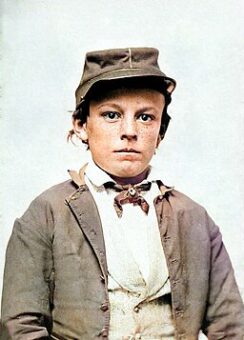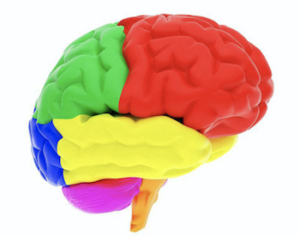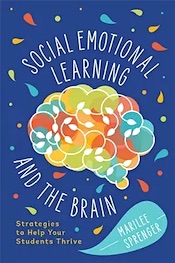5 Ways to Be Sure That Lessons Stick in Memory
By Marilee Sprenger
 What makes our lessons memorable? As a memory researcher for the past 30 years (which began as a seventh grade teacher trying to figure out what my students could remember and why they so easily forgot) I know the answer to this question is worthwhile.
What makes our lessons memorable? As a memory researcher for the past 30 years (which began as a seventh grade teacher trying to figure out what my students could remember and why they so easily forgot) I know the answer to this question is worthwhile.
The memory lanes I wrote about in my first book, Learning and Memory: the Brain in Action, haven’t changed. We all store information in one or all of the following: semantic, episodic, emotional, procedural, or automatic memory. These are long-term storage systems in our brains. Here’s a quick review:
✻ Semantic: words, texts, lectures, videos, anything word based
✻ Episodic: what happened and where
✻ Emotional: any experience that evokes an emotion
✻ Procedural: movement based (acting things out, dance)
✻ Automatic: non-motor procedural; comes with repetition (decoding words, the alphabet)
What are some tried and true ways to help information stick in adolescent brains? Let’s look at five learning activities that call on some or all of these long-term memory storage systems.
Visuals
Only 10-20% of written or spoken information is remembered after three days, but 65% of visual information is retained. I’m fascinated by the reality that the Liberty Bell is memorable, but liberty is not.
How can we make content stick like the Liberty Bell? A picture is conjured in your brain as you read those words, but liberty in isolation demands that your brain work a little harder.
We’re talking about adolescents here. We know they stare at their phones and watch TikTok videos constantly. Attaching the principles of liberty to videos, pictures, models, charts, films, posters, skits, statues, mixed media makes for sticky learning. With visual information, a lot can be stored and processed later.
Graphic organizers also become visuals that are memorable. Bring back those Venn diagrams, concept maps, mind maps, and KWL charts if you have abandoned them. They can also be emotionally “sticky.” When students work together to express their learning using these visual aids, they boost their memorability through relationship building that may include humor and other emotions that stamp that experience as worth remembering.
(“What did you learn today?” “Nothing. But Justin fell off his chair while we were drawing the pictures for our mind map on the Holocaust today in social studies!” “What did you have on the mind map?” “Well, we put…”)
Ask students to teach others with visuals. Have them visually demonstrate your content. This is a powerhouse of memorability! Whether they use Google Slides or posters – or even if they role play and act out their learning – they have to know the material to teach it. And the other students get a visual representation of the learning to add to their own!
Memory systems: semantic, episodic, emotional, procedural
An emotional experience
Basing my lessons on the episodic thought Every time you learn something you are somewhere I tried to make every lesson an experience and something that could be easily transferred to other locations. (Seventh grade math students couldn’t multiply with decimals in my ELA class, but when I had them walk down to their math classroom, they remembered how!)
So, how do I make the experiences emotional? Storytelling is probably my best friend. The brain loves stories, and the adolescent brain is no exception. Stories help the brain organize information. Beginnings, middles, and endings…you have to love them!

Library of Congress, Public domain, via Wikimedia Commons
When I began a lesson on the Civil War and explained how uncomfortable the uniforms were that the young drummer boys…adolescents…were wearing, all I had to do is make the story about one boy, give him a name, and suddenly my class is very interested in his experience.
“James was in the Confederate Army, just like his five brothers. When he went to get his uniform, he was handed a blue wool pair of pants and shirt. (Wait, blue? What were the Confederate colors? That’s right, gray…James might be shot by his own army because he was wearing the North’s colors!) He put on these clothes that would be the only thing he would wear for months, and under the burning sun and a temperature of 90 or so degrees, he couldn’t stop sweating…and itching!”
I did my best to carry James through the entire war with questions like, “If James were in this battle, how do you think he felt? What do you think he would do?” Sometimes we marched around the classroom, holding books or backpacks, just enough for my students to feel tired and maybe a little sweaty! Stories are powerful and memorable.
Memory systems: episodic, semantic, emotional, procedural
Play based learning
Play based learning is a life event that encompasses many memory systems and makes learning so memorable. When I changed schools and went from teaching kindergarten to teaching seventh grade, I was petrified. But it didn’t take long to discover that the same strategies work for both grade levels!

Source: NNCI
Playdoh is a favorite medium for me. I always teach my students about their brains and nervous systems, and Playdoh brains are fun to make and provide students with fun interaction and a wealth of knowledge about themselves.
Maker spaces provide a place for play and interactive learning and don’t have to be technology based. These pop-up labs may contain sidewalk chalk, thread, Legos, glue, paint and glitter that can all be used to create and learn. You may have the resources for 3-D printers, but if not, play can come from basic tools.
Memory systems: semantic, episodic, procedural, emotional
Stations
Stations of all kinds can provide students with memorable learning. Learning stations can offer items that students can use to show what they know – in that sense, they can also be visual tools. Creativity can be encouraged through stations. One of my favorites: illustrating the next chapter of a book with art supplies and simple drawings.
One 6th grade teacher I observed used a “choose your own adventure” theme. Students worked in pairs or small groups to design the possible next steps for a novel they were reading. Each group presented their “next chapter,” and students voted on which adventure they preferred.
Memory systems: semantic, episodic, emotional, procedural
Rhymes, Songs, and Chants
I have long been a proponent of singing the information. Back to my earliest days of teaching when we were expecting students to know every part of speech by heart, I had my students sing prepositions, helping verbs, and pronouns. (How many of us learned the ABCs through song?)
Not a necessity these days, BUT there is still information that needs to be placed in the fifth memory system, automatic. This is actually non-motor procedural memory, and I highly recommend songs and jingles in my vocabulary books and suggestions for quick daily vocab lessons. I compare these tuneful ditties to visuals in terms of stickiness.
A lot of information goes into a brief amount of words that students can use to reflect and expand upon. For instance, there are many academic words that students need to know for standardized testing, and many of these same words should show up in their writing. These are words like analyze, demonstrate, cite, evaluate, point of view, etc.
Since our most important assessments are timed, it is necessary that students automatically know what these words mean when seen on the test. My students learned these words through rhymes and chants, “analyze, break it down, down, down, then you’ll see what you found, found, found.”
Learning the jingle was simple enough; then as drawings were added, along with examples, this became an easy word to understand. Sixth, seventh, and eighth grade students come back to see me and recited jingles and songs to show me how good their memories were!
Memory systems: automatic
Also see Marilee’s 2018 MiddleWeb article:
7 Brain-Based Ways to Make Learning Stick
Memories are made of this!
As the school year is winding down, it often becomes more difficult to engage our students. Perhaps a few of these ideas will spark some thoughts to help make your content more palatable to those hungry middle school minds that may be trying your patience. If school is out for you, starting planning for a more “memorable” fall!

Marilee was a classroom teacher for 25 years, mostly at the middle school level. Her bestsellers include How to Teach So Students Remember (2nd Edition), Social Emotional Learning and the Brain; and her latest, The Missing Link to Help Them Think: Connecting Executive Function and SEL Skills to Boost Student Achievement, all from ASCD.
Marilee can be reached at her website and at brainlady@gmail.com. Find all her MiddleWeb posts here.































